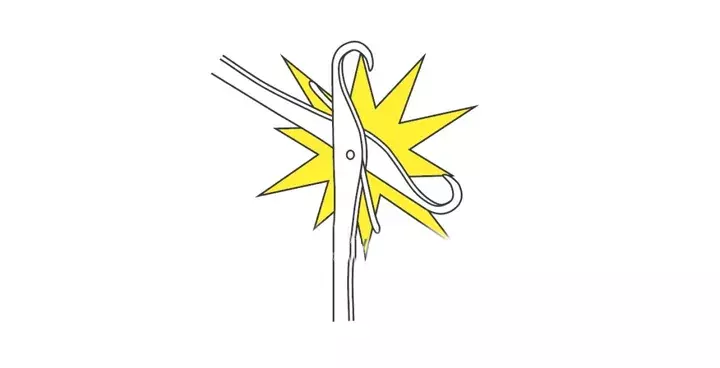Nguyên nhân và biện pháp đối phó với máy dệt kim tròn
Nov 11, 2023
Needle collisions in circular knitting machines refer to instances where knitting needles, during the operation of the equipment, experience impacts or breakage of the needle shank. Typically, needle shank breakage is more common. If needle breakage occurs, it is abnormal, and when this happens, it is essential to determine if the needle broke at the knitting position or the side with more or fewer needle latches (indicating the collision position). This helps identify the specific location of the needle break on the sinker.

1. Issues with the Sinker:
(1) kim lỏng lẻo hoặc chặt chẽ-phù hợp với chìm: Excessive wear on the knitting needle or sinker can result in increased lateral movement, causing needle collisions. Some specialized materials may require thinner knitting needles in wider needle cylinders, increasing the risk of collisions.
(2) Insufficient or Excessive Sinker Groove Depth: If the sinker groove is too tight or too deep, it can impede the proper movement of the knitting needle, leading to needle collisions. The depth of the groove should ideally allow the knitting needle to be slightly below the sinker surface.
(3) Sinkers with Uneven Surfaces: Prolonged friction on sinkers can result in uneven surfaces, increasing the likelihood of needle collisions.
2. Triangle Issues:
(1) Lack of Bevel or Excessive Bevel: A lack of bevel or excessive bevel on the entry surface of the triangle can lead to needle collisions. An insufficiently smooth entry surface or excessive bevel can contribute to collisions.
(2) Excessive Slope Angle of the Triangle: Increasing the slope angle of the triangle enhances the force on the needle latch in the tangential direction during machine operation, making needle collisions more likely, particularly in flat-ground triangles.
(3) Excessive Gap Between Triangles: If the gap between triangles is too large, knitting needles may get caught between them, causing collisions. The gap between triangles should ideally not exceed the thickness of a single knitting needle, which is around 0.10-0.20mm.
(4) Irregular Surface of the Triangle: Prolonged friction on triangles can result in irregular surfaces, increasing the risk of needle collisions.
(5) Vấn đề kênh kim tam giác: Unprocessed broken needle shanks or narrow needle channels in triangles can contribute to needle collisions.
(6) Improper Installation of Triangles or Triangle Seats:Lắp đặt không đúng hình tam giác hoặc ghế van, bao gồm vít cố định nhô ra hoặc bề mặt bẩn trong quá trình lắp đặt, có thể gây ra va chạm kim.
(7) Material Issues or Improper Heat Treatment of Triangles: Soft or improperly heat-treated triangle materials can lead to impact resistance issues or brittle fractures, causing needle collisions.
(8) Non-Perpendicular Triangle Needle Channels:Trong trường hợp bình thường, mặt phẳng của rãnh kim tam giác phải vuông góc với mặt phẳng của tam giác. Sự lệch lạc có thể xảy ra trong quá trình phay, ảnh hưởng đến tiếp xúc giữa kim dệt và kênh kim tam giác.
3. Other Causes:
(1) Quality Issues with Knitting Needles: Poor-quality knitting needles with low strength can result in needle collisions.
(2) Rãnh kim thiếu bôi trơn: Insufficient lubrication in needle channels can increase friction and the risk of needle collisions.
(3) Presence of Moisture in Needle Oil: Moisture in needle oil can reduce lubrication effectiveness and lead to needle collisions.
(4) Khoảng cách giữa ống tiêm (đĩa) và tam giác quá lớn: Large clearances between needle cylinders (disks) and triangles can cause knitting needles to deviate from the correct path, resulting in collisions.
(5) Introduction of a Significant Amount of Lint or Yarn into the Needle Hook: Feeding a large amount of lint or tangled yarn into the needle hook can obstruct the descent of knitting needles during pressing, causing needle latch breakage.
(6) Vị trí đĩa kim nhảy quá mức:Do thiết bị hoạt động không ổn định hoặc cuộn kim không căn chỉnh, vị trí cuộn kim có thể nhảy quá mức, dẫn đến va chạm kim.
(7) Khoảng cách bánh răng quá lớn hoặc ổ trục một chiều bị hư hỏng:Khoảng hở bánh răng lớn hoặc hư hỏng ổ trục một chiều có thể gây ra quay ngược khi dừng nhanh, dẫn đến va chạm con lăn kim.
(8) Điều chỉnh thích hợp của máy cuộn vải:Thả lỏng căng thẳng trên máy cuộn vải một cách thích hợp có thể ngăn chặn va chạm kim, đặc biệt là trong các máy cũ với nhiều vấn đề.
Tóm lại, giải quyết những nguyên nhân này và thực hiện các quy trình bảo trì thích hợp có thể làm giảm đáng kể sự xuất hiện của các mũi kim tròn trong máy dệt kim tròn. Kiểm tra, bôi trơn và điều chỉnh thường xuyên là rất cần thiết để đảm bảo hoạt động trơn tru và không gặp sự cố.
next: Chức năng, nguyên tắc và quy trình làm việc của máy dệt kim tròn
previous: Bảo trì máy dệt kim tròn
